Are you curious about how the BOM Perth radar works and why it’s crucial for weather forecasting in Western Australia? The Bureau of Meteorology’s radar system in Perth is an advanced tool that provides real-time data on rainfall, storms, and wind patterns, helping to keep communities safe and informed. But how accurate is the Perth weather radar and what makes it different from other radar systems across Australia? Many people rely on this technology to plan their daily activities, especially during the unpredictable storm seasons. With climate change causing more extreme weather events, understanding the capabilities of the BOM radar Perth becomes even more important. Have you ever wondered how meteorologists predict sudden downpours or thunderstorms using radar imagery? This powerful system scans the skies continuously, offering vital information that impacts everything from agriculture to emergency services. In this article, we will explore the fascinating technology behind the BOM Perth radar, uncover the latest updates, and reveal tips on how to interpret radar data yourself. Whether you’re a weather enthusiast or simply want to stay prepared for Perth’s often volatile weather, learning about this radar system will empower you with knowledge like never before. Get ready to dive deep into the world of meteorological radars and discover why the BOM Perth radar is a game-changer!
How BOM Perth Radar Enhances Accuracy in Severe Weather Predictions Across Western Australia
When it comes to weather watchin’ in Western Australia, the bom perth radar is like your best mate who never lets you down. You know, that gadget thing they use to see if it’s gonna rain or if the sky is clear without you having to step outside and look like a right muppet. But seriously, this radar system is more than just a fancy toy – it’s a crucial tool for farmers, surfers, and anyone who depends on the weather being somewhat predictable.
Let’s dive into what makes the bom perth radar tick, or at least try too. The Bureau of Meteorology (BOM) operates this radar from a spot near Perth, and it continuously scans the atmosphere for rain, thunderstorms, and other weather nasties. Not really sure why this matters, but did you know that the radar sends out pulses of microwave energy that bounce off raindrops and then return? The time it takes to return tells the radar how far away the rain is, and the strength of the signal tells how heavy the rain is. It’s like some sci-fi stuff, but it’s real and pretty handy.
Now, if you’re a bit of a tech geek, or just curious, here’s a quick rundown of the radar’s specifications, in a table I whipped up because tables make things clear, right?
| Feature | Details |
|---|---|
| Location | Perth, Western Australia |
| Frequency | 2.8 GHz |
| Range | Up to 256 km |
| Scan Rate | 6 rotations per minute |
| Data Update Frequency | Every 6 minutes (approx.) |
This means the bom perth radar can cover a wide area and update pretty frequently to give near real-time data. But sometimes, those updates might lag a bit or show some glitches—usual tech problems, nothing to freak out about.
One thing that gets me scratching my head is how the BOM presents all this radar data on their website. It looks like a colourful mess of blobs and streaks moving around on a map. If you’re not used to it, you’d probably think someone spilled paint over Australia. But each colour indicates different rain intensities or types of precipitation. Blue and green usually means light rain, while yellows and reds are the heavy stuff. If you see purples or pinks, buckle up – there might be hail or thunderstorms brewing.
Here’s a little cheat sheet for those colours, just so you can impress your mates next time you’re checking the weather:
| Colour | Rain Intensity or Phenomenon |
|---|---|
| Blue/Green | Light rain |
| Yellow | Moderate rain |
| Red | Heavy rain |
| Pink/Purple | Hail or thunderstorms |
Maybe it’s just me, but I feel like sometimes these colours don’t always match what’s actually happening outside. Like, the radar shows heavy rain, but it’s just drizzling. Or the radar says clear skies but you’re getting soaked. Radar isn’t perfect, but it’s probably the best we got.
For anyone wondering how to access this info, the bom perth radar data is available on the BOM’s official site, and even on some weather apps. Here’s a quick step-by-step for the uninitiated:
- Go to the Bureau of Meteorology website.
- Navigate to the radar section.
- Select “Perth” from the radar locations.
- Watch the radar animations to see live weather updates.
- (Optional) Use the zoom and time sliders to check past or future projections.
One practical insight is that if you live in or near Perth, keeping an eye on this radar can save you from getting caught in unexpected showers or storms. Especially during the summer months when those sneaky thunderstorms like to pop up out of nowhere. You might even avoid a soggy picnic or a ruined day at the beach.
Speaking of storms, the bom perth radar also helps emergency services to prepare for severe weather events. When the radar picks up a developing thunderstorm, warnings can be issued to the public. Not really sure why this matters, but it’s kinda reassuring to know that these warnings come from some fancy tech that’s scanning the sky 24/7.
One thing that often puzzles people is the “radar echoes” – sometimes the radar picks up signals that aren’t rain at all. Birds, bugs, or even dust can show up on the radar and look like it’s raining cats and dogs. This is called “clutter” and meteorologists have to filter this out to get accurate readings. It’s like trying to hear your phone ring in a noisy pub.
If you’re a bit of a data nerd, the BOM also releases downloadable datasets from their radar systems. These datasets are used by researchers, weather
Top 5 Ways BOM Perth Radar Revolutionises Real-Time Storm Tracking and Flood Warnings
If you ever been curious about the bom perth radar, you might be in for a bit of a ride. Now, I’m not really sure why this matters to everyone, but the radar system out in Perth is actually pretty important, even if it doesn’t get much spotlight like it should. For those who are a bit weather obsessed or just want to know if it’s gonna rain or not, the bom perth radar is like a crystal ball of the skies above Western Australia.
So what exactly is this radar thing? Basically, it’s a giant machine that beams out radio waves to detect stuff in the atmosphere. When the waves hit raindrops or hail, they bounce back, and that’s how meteorologists get their info. It’s like echo-location but for weather. The data collected by the bom perth radar helps predict storms, rain, and other weather shenanigans that could be headed your way.
Now, let me try and break this down in a table, ‘cause who doesn’t love a good chart?
| Feature | Description | Why it matters |
|---|---|---|
| Location | East of Perth, near Roleystone | Covers Perth metro and surrounds |
| Range | About 240 kilometres radius | Detects weather well beyond city |
| Update Frequency | Every 6 minutes typically | Keeps info fairly fresh |
| Types of Precipitation | Rain, hail, drizzle, thunderstorms | Helps warn about severe weather |
Not sure if you knew this, but Perth’s weather can be quite unpredictable sometimes. The bom perth radar tries to keep up, but it’s not perfect – like, imagine trying to predict the exact minute it’ll start raining when the clouds are playing hide and seek. The radar data is often combined with satellite images and ground observations to make a better picture of what’s going on.
Maybe it’s just me, but I feel like the bom perth radar is a bit underappreciated. It’s like this unsung hero doing its job day and night. If you’re living in Perth or nearby, it’s probably the best tool we got to know if a downpour or a storm is on the horizon. Sure, there’s weather apps and all, but they all rely on the same data underneath.
Let’s look at a quick example of how the radar info might be used in real life:
- A thunderstorm is forming 150 km east of Perth.
- Radar picks up increasing rainfall intensity and movement towards the city.
- Meteorologists issue warnings for possible heavy rain and hail.
- Local residents get alerts on their phones.
- People prepare by closing windows, securing outdoor furniture, or cancelling plans.
It’s like a domino effect, all starting from those radar signals bouncing back to the BOM headquarters.
One thing that’s kinda fascinating is how the radar can differentiate between types of precipitation. It’s not just “rain or no rain.” The radar can tell if the droplets are big or small, if there’s hailstones, or if it’s just a light drizzle. This is done through interpreting the intensity and velocity of the radar echoes. Not really sure why this matters, but it definitely helps emergency services and farmers make better decisions.
Below is a little list of practical insights or tips if you want to use the bom perth radar effectively:
- Check the radar regularly during storm season (usually summer).
- Look for colour changes from light blue to red on the radar map – red means heavy rain.
- Don’t rely on radar alone; cross-reference with weather warnings.
- Use the radar to time your outdoor activities better.
- Remember radar has limitations – it doesn’t see through mountains or buildings well.
I once tried to track a storm using the bom perth radar and got a bit confused ‘cause the images looked like a bunch of blobs moving around randomly. Turns out the radar data needs some experience to interpret correctly. It’s like reading tea leaves but with science!
Here’s a quick snippet of the radar data from their website, showing different precipitation intensities:
| Colour on Radar | Intensity Level | Description |
|---|---|---|
| Light Blue | 0-10 mm/hr | Light rain or drizzle |
| Green | 10-20 mm/hr | Moderate rain |
| Yellow | 20-40 mm/hr | Heavy rain |
| Red | 40+ mm/hr | Very heavy rain/hail |
If you ever wondered why sometimes the radar image suddenly goes blank or shows weird spots, that’s probably due to technical issues or interference. Radar systems are high-tech but they ain’t perfect. Also, sometimes birds or even planes can show up on the radar, confusing the data a bit.
In terms of accessibility, the bom perth radar data is
What Makes BOM Perth Radar a Game-Changer for Local Farmers and Outdoor Enthusiasts?
When it comes to tracking the weather around Perth, the bom perth radar is pretty much the go-to tool for most folks. Now, I’m not really sure why this matters to everyone, but weather updates are like the lifeblood of daily planning here in Australia, especially in Perth where the weather can swing like a pendulum. The Bureau of Meteorology (that’s BOM for short) runs this radar system, and it helps in predicting storms, rains, and all sorts of atmospheric dramas that might pop up unexpectedly.
So, what exactly is this bom perth radar? In simple terms, it’s a high-tech system that sends out radio waves or microwaves into the sky and waits for them to bounce back from rain droplets, hail stones, or any other precipitation. It then interprets these signals to give us a snapshot of where the rain is, how heavy it is, and how fast it might be moving. Sounds pretty neat, right? But the technology behind it is actually quite complex and sometimes, the radar signals get all muddled up by interference or weird atmospheric conditions. Not perfect, but it does the job most of the time.
Let’s break down some of the key features and info you might want to know about the bom perth radar in a little table, just to keep things clear:
| Feature | Description | Notes |
|---|---|---|
| Location | Near Perth, Western Australia | Covers a wide area around Perth |
| Frequency | S-band radar (around 2.7–3.0 GHz) | Good for penetrating rain clouds |
| Update Frequency | Every 5 to 10 minutes | Pretty quick for real-time updates |
| Coverage Radius | Approx 250 km radius | Includes Perth metro and surrounds |
| Data Types | Reflectivity, Velocity, and Precipitation | Helps predict rainfall intensity |
It’s quite handy, especially when you’re trying to figure out if you should carry your umbrella or not. I mean, it’s Perth, sometimes the sun shining and next minute it’s chucking it down. The bom perth radar tries to keep you in the loop, but sometimes it can be a bit temperamental. Like, it might say “rain coming” but then you get nothing but a breeze. Or vice versa, no warning and you get soaked to the skin. Classic Perth weather, eh?
If you’re wondering about how you can access this radar info, it’s mostly available on the Bureau of Meteorology’s website or through their mobile apps. They provide live radar images which look a bit like colourful blobs moving across a map – green for light rain, yellow to red for heavier rainfall. Here’s a quick checklist if you want to get the most out of the bom perth radar data:
- Check the update time to make sure info is current
- Look for the colour scale to understand rain intensity
- Use the velocity data if you want to predict storm movement
- Compare recent images to see how weather systems move
One thing that’s kinda interesting (or maybe not, depends on your interest) is how the radar data helps not just everyday folks, but also emergency services. When bushfires or floods are a risk, having real-time info from the bom perth radar can be a lifesaver. It’s like having a weather crystal ball, except it’s made of tech and science. But sometimes the radar can’t detect everything perfectly, especially when there’s heavy hail or other weird weather phenomena. So, relying on it 100% might not be the best idea – always good to cross-check with forecast updates.
Also, the radar’s coverage isn’t just limited to the city of Perth itself. It covers a pretty huge area surrounding the city, which is useful for farmers, pilots, and even fishermen who need to know the weather conditions over a larger region. Here’s a simple list of who benefits from the bom perth radar data the most:
- Local residents planning their day
- Commuters avoiding bad weather
- Emergency response teams
- Farmers monitoring rainfall for crops
- Aviation industry for flight safety
- Marine operators checking sea conditions
Now, the radar images can be a bit tricky to interpret if you’re not used to it. The colours and patterns might look like some abstract artwork to a newbie. But once you get the hang of it, it’s quite straightforward. Maybe it’s just me, but I always find the velocity images the most fascinating because you can actually see the wind patterns and storm rotations. It’s kinda like watching nature’s own dance, but on a computer screen.
One last thing to mention about the bom perth radar is that it’s regularly maintained and upgraded. Technology doesn’t stand still, and neither does the BOM. They keep improving the radar’s sensitivity and accuracy to give us better
Exploring the Latest Technology Behind BOM Perth Radar and Its Impact on Climate Monitoring
When you think about weather forecasting in Australia, especially in the west, the bom perth radar is kinda the unsung hero, isn’t it? I mean, everyone talks about Sydney or Melbourne weather, but Perth’s radar system does a big job keeping an eye on the skies out there. Not really sure why this matters, but the bom perth radar helps track storms, rain, and even those rare but scary dust storms that blow across the desert into the city.
Now, if you’re wondering what exactly the bom perth radar does, let me break it down a bit. It’s basically a radar station operated by the Bureau of Meteorology (BOM), which is the official weather agency in Oz. The radar sends out pulses of radio waves, and when these waves hit rain droplets or other particles in the air, they bounce back. The radar then interprets these signals to figure out where the rain is, how heavy it is, and how fast it’s moving. Simple as that, but also kinda complex if you think about the technology behind it.
Here’s a quick snapshot of what the bom perth radar tracks:
| Parameter | Purpose | Why it’s important |
|---|---|---|
| Rainfall Intensity | Measures how much rain is falling | Helps predict flooding or dry spells |
| Wind Speed | Tracks wind directions and speeds | Crucial for storm warnings and aviation |
| Storm Movement | Follows the path of storms | Alerts communities to approaching weather |
Sometimes people think radars are only useful for rain, but nah, they do much more. For example, during summer, Perth is famous for those wild thunderstorms. The bom perth radar can give early warnings about lightning and hail, which can be lifesavers, especially if you’re out camping or on the road. Oh, and speaking of which, the radar coverage extends pretty far, covering not just the city but also the surrounding regions, which is great for farmers and bushwalkers alike.
One thing that kinda bugs me though, is how sometimes the radar image looks all pixelated and confusing when you’re trying to check the weather quickly on your phone. Maybe it’s just me, but I feel like they could make the user interface a bit more user-friendly. Especially if you’re not a meteorologist or a tech whiz, it can get overwhelming with all the colours and blips on the screen. For those who wanna dive deeper, the BOM website offers detailed radar loops and animations, showing how weather systems move over time, which is pretty neat.
Let me list down some common uses of the bom perth radar that you might not have thought about:
- Monitoring bushfire smoke plumes to see where the smoke is heading
- Tracking dust storms during dry seasons
- Helping pilots navigate safely by providing real-time weather updates
- Assisting local governments in emergency planning and response
And now, a cheeky little table showing the different radar types used by BOM around Australia, including Perth:
| Radar Type | Location | Coverage Radius (km) | Primary Use |
|---|---|---|---|
| C-band Radar | Perth | 150 | General weather monitoring |
| S-band Radar | Darwin | 300 | Tropical cyclone tracking |
| X-band Radar | Various | 20-40 | Localised severe weather |
If you’re into tech specs (and who isn’t, right?), the bom perth radar operates on the C-band frequency, which is a good balance between range and resolution. This means it can see pretty far, but also picks up details like rain intensity quite clearly. Although, in heavy rain or hail, sometimes the radar signal can get blocked or distorted — which is called attenuation. Don’t ask me why they don’t just fix that, but it’s a limitation of the technology.
I reckon one of the coolest things about the bom perth radar is how it integrates with other weather tools. For instance, the radar data is combined with satellite images, weather stations, and computer models to give a full picture of the weather. This is why BOM forecasts are often pretty accurate, even if the weather in Perth can change faster than you can say “sunshine.”
For those who wanna get their hands dirty and actually use the bom perth radar data, there are APIs and open datasets provided by BOM. You can plug these into apps or websites to build your own weather tracking tools. Here’s a quick breakdown of what you might need:
| Data Type | Format | Typical Use Case | Accessibility |
|---|---|---|---|
| Radar Reflectivity | PNG, GIF | Visual weather maps | Public |
| Rainfall Rates | CSV, JSON |
Why BOM Perth Radar Is Essential for Emergency Services: Unveiling Its Life-Saving Capabilities
If you ever been curious about the bom perth radar, then you’re in for a bit of a ride through meteorological madness and techy stuff that might not make much sense at first glance. Honestly, I’m not really sure why this matters, but apparently, it’s a big deal for folks living in Western Australia who want to know if the rain’s coming or if they should pack an umbrella (or not). So, sit tight, grab a cuppa, and let’s dig into what this radar thingy actually does — or tries to do.
What is the bom perth radar anyway?
At it’s core, the bom perth radar is a weather radar system that the Bureau of Meteorology (BOM) uses to monitor rainfall, storms and other weather conditions around Perth and its surrounds. It’s one of those high-tech gadgets that spin around sending out microwave pulses and listens for the echoes that bounce back from rain drops. From this, it figures out where the rain is falling, how heavy it is, and how it might be moving. Sounds simple, but the technology behind it is quite complex — and sometimes it acts up, which can be frustrating for weather geeks.
Now, the radar sit on a tower just east of Perth, near the suburb of Gnangara. It cover a huge area, approximately 150 km radius, which means the BOM can track weather systems way beyond just the city itself. This is pretty handy when you want to keep an eye on storms brewing out in the Indian Ocean or in the hills around Perth.
Table 1: Key Features of the bom perth radar
| Feature | Details |
|---|---|
| Location | Gnangara, Perth |
| Coverage Radius | Approx. 150 km |
| Frequency | 5.6 GHz (S-band) |
| Scan Speed | About 6 rotations per minute |
| Primary Use | Rainfall and storm monitoring |
Why should you care about this radar thing?
Well, if you live in Perth (or nearby), the bom perth radar is pretty much your go-to for understanding the weather. But maybe it’s just me, but I feel like sometimes the radar images can look like abstract art rather than useful weather info. You see those colourful blobs that move around on your phone or on the BOM website? That’s the radar’s way of telling you where rain or storms might be happening. The colours usually range from green (light rain) to red or purple (heavy rain or hail).
One practical use of the radar is for farmers, who need to know if they’ll get enough rain for their crops or if a big storm is coming to wreck their day. Also, emergency services rely on it to prepare for bushfires, floods or severe storms. So, yeah, even if the radar images look confusing, they play a vital role in keeping people safe.
How to read the bom perth radar images
Reading radar imagery isn’t as straightforward as reading a weather forecast on telly. Here’s a quick cheat sheet to help you decode the colours:
- Light Green: Light rain showers, nothing to worry about
- Dark Green: Moderate rain, maybe grab your raincoat
- Yellow: Heavy rain, likely to cause puddles and wet shoes
- Red: Very heavy rain or hail, better stay indoors
- Purple: Severe storms, possible hail or damaging winds
Don’t forget that these radar images update every few minutes, so the weather can change pretty quickly. Also, the radar doesn’t see everything perfectly — sometimes hills, buildings or other obstacles can block the signals, causing “shadows” or gaps in the data.
Listing 1: Pros and Cons of bom perth radar
Pros:
- Provides real-time weather updates
- Covers a large area around Perth
- Helps in early storm warnings
- Supports emergency response planning
Cons:
- Sometimes affected by terrain interference
- Radar images can be confusing for non-experts
- Doesn’t show rain intensity at ground level perfectly
- Occasional technical glitches cause delays
Funny enough, sometimes the radar picks up things that aren’t rain at all — like flocks of birds or even insects. These “false echoes” can make the radar data look weird and untrustworthy, which doesn’t help anyone who’s trying to figure out if they need a brolly.
Practical Insight: Using bom perth radar on your phone
Most of us these days rely on apps to check the weather, and the BOM website or app usually includes the bom perth radar images. They update almost in real-time, so you can watch the weather coming and going. But be warned, the radar can be a bit slow or glitchy on older phones — or when the internet connection isn’t great.
Here’s a little tip: if you want to keep track of a storm heading your way, try to watch
Conclusion
In conclusion, the BOM Perth radar plays a crucial role in monitoring and forecasting weather conditions across Western Australia. Its advanced technology enables accurate detection of rainfall, storm activity, and severe weather events, providing vital information for both the public and emergency services. By offering real-time data and comprehensive radar imagery, the BOM Perth radar enhances preparedness and helps mitigate the impact of adverse weather. Understanding how to interpret radar outputs can empower individuals and communities to make informed decisions during changing weather patterns. As climate variability continues to challenge traditional forecasting methods, the ongoing development and maintenance of radar infrastructure remain essential. For those interested in staying ahead of Perth’s weather, regularly consulting the BOM radar updates is highly recommended. Ultimately, embracing these technological tools not only supports safety but also contributes to a greater awareness of our dynamic environment. Stay informed, stay safe, and make the most of the valuable insights provided by the BOM Perth radar.













